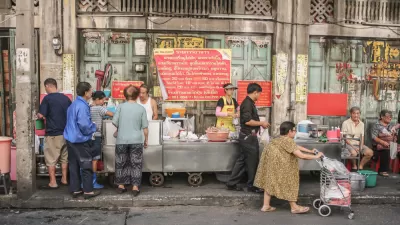In the latest entry in a series on informal urban livelihoods, Sally Roever of WIEGO provides insight into how planners can better understand, acknowledge and manage street vending through the development of appropriate policies and best practices.
"Street vending has persisted for centuries all over the world, despite a multitude of efforts to curtail it," writes Roever. As the barriers of entry are virtually non-existent, and since it provides easy access to curbside consumers, street vending appeals not only to individuals seeking basic survival, but also to more seasoned entrepreneurs looking to make an extra dollar. Much to the chagrin of big business and other elites, however, street vendors compete for prime city space.
"Street vendors strategically locate their workplaces in urban areas with steady pedestrian flows, often in central business districts or near crowded transport junctions." Aside from economic competition, unregulated street vending can lead to overcrowding, aggravating "traffic congestion, solid waste management, and public health" matters, adds Roever. Referring to two case studies, she attempts to demonstrate how planners can balance competing demands by city stakeholders, including traders, with innovative and participatory approaches.
The first example explores interventions at the national level, namely the formulation of an unprecedented type of bill of rights for street vendors in India. The passage of this bill was made possible by earlier policy efforts at the ground level spear-headed by groups such as National Association of Street Vendors of India (NASVI) and the Self Employed Women's Asssociation (SEWA). And the second example looks at a local project in Durban, South Africa's busy Warwick Junction, aimed at ameliorating congestion and design matters. According to Roever, "[t]he National Policy in India, and the Warwick project in Durban, have had a considerable impact on urban livelihoods."
She concludes, "[the] key innovation in both Durban and Bhubaneswar was to recognize that it makes sense to keep street vending in natural market areas of the city."
FULL STORY: How street vendors and urban planners can work together

Alabama: Trump Terminates Settlements for Black Communities Harmed By Raw Sewage
Trump deemed the landmark civil rights agreement “illegal DEI and environmental justice policy.”

Study: Maui’s Plan to Convert Vacation Rentals to Long-Term Housing Could Cause Nearly $1 Billion Economic Loss
The plan would reduce visitor accommodation by 25% resulting in 1,900 jobs lost.

Planetizen Federal Action Tracker
A weekly monitor of how Trump’s orders and actions are impacting planners and planning in America.

Grand Rapids Mayor Proposes Garage Conversion Plan
The mayor says allowing homeowners to convert garages to dwelling units could alleviate the city’s housing shortage.

Baltimore Ordered to Improve Sidewalk Accessibility
The city is one of many to face lawsuits for failing to comply with the Americans with Disabilities Act.

This Toronto Suburb Has More Bus Riders Than Columbus, Ohio
Brampton, Ontario used gradual improvements in service to prove that if you build it, they will ride.
Urban Design for Planners 1: Software Tools
This six-course series explores essential urban design concepts using open source software and equips planners with the tools they need to participate fully in the urban design process.
Planning for Universal Design
Learn the tools for implementing Universal Design in planning regulations.
Smith Gee Studio
Alamo Area Metropolitan Planning Organization
City of Santa Clarita
Institute for Housing and Urban Development Studies (IHS)
City of Grandview
Harvard GSD Executive Education
Toledo-Lucas County Plan Commissions
Salt Lake City
NYU Wagner Graduate School of Public Service





























